
A while back, I had the special opportunity to attend an advanced painting workshop at the Sedona Arts Center in Arizona with master landscape painter, Michael Workman.

I was very excited about this experience because I have admired this elusive artist’s work for many years, plus Michael is an ‘artist’s-artist’, and one of the greatest landscape painters of our time. I was interested in learning how Michael ‘deconstructs’ his paintings and balances between a realistic approach and abstract interpretation. Click the images below to enlarge Michael’s paintings.

‘Mike’ takes an organic approach toward teaching. With the painting workshop in such a picturesque setting such as Sedona, I expected to do a lot of plein air painting on location. The weeklong workshop included many thought provoking lectures and generous demonstrations. Michael taught us about a lot about his philosophy on composition and his use of the Golden Rectangle.
Suggested Reading:
“Elements of Dynamic Symmetry”
“Carlson’s Guide to Landscape Painting”
It is impossible for me to share all that we learned during our week in Sedona, but I hope you will enjoy some of the week’s highlights and Michael Workman’s insightful quotes.
“If you can’t draw, it’s hard to be a good painter.”
“If you have nothing to say, it is not art.”
“Don’t pander to the level of the viewer.”
“People want to skip to the end without doing the work to get there.”
“I am willing to fail over and over again, until I get it right.” (this is Michael’s modus operandi)
“To be a good artist, you have to be opinionated.”
“If you are not frustrated, you are probably doing it right.”
“I have to go to the studio each day to prove that I can paint.”
“The same principles apply to painting cityscapes as landscapes.”
“Think in terms of ‘sketching’ or drawing with paint.”
“Most of the painting problems are caused by bad drawing, value and color.”
“When you paint everything so obviously, you lose the poetic mystery.”
“What you leave out is more important than what you leave in.”
Great artists have the ability to leave out the superfluous.”
“At the end of a painting session, I always obliterate the painting so I have something to come back to work on the next day.”
“I believe in God and I want it to show in my landscapes.”
The 30, 3, 3 Rule:
- A painting should grab your attention at 30 feet away.
- At 3 feet away, the painting should tell a story and create a dialog with the viewer.
- 3 inches away, the painting should be interesting to other artists with interesting texture and paint application.
Painting support:
- Michael paints on Baltic Birch wood panels, and hardboard panels.
- Most often Mike makes his own cradled boardswith 1/2 inch plywood strips secured with wood glue.
- He makes his own painting panels and covers them with ‘bleached muslin’ and sometimes 100lb watercolor paper with 3-4 layers of acrylic gesso.
- He sands in-between the first and second coats.
- After the gesso is dried, Mike tones the boards.
 (Mike doesn’t use a brush, but he ‘trowels’ on the gesso.)
(Mike doesn’t use a brush, but he ‘trowels’ on the gesso.)
Palette:
Mike uses a very minimal palette. Sometimes he will add a brighter yellow and a few other transparent pigments for his glazing.
- Ultramarine Blue Deep
- Cerulean Blue
- Titanium White
- Cad Yellow Lt
- Cad Red Lt
- Alizarin Crimson
- Burnt Sienna
- He makes his ‘blacks’ using burnt sienna and ultra marine blue.
- He uses very little paint!
Mediums:
- Mike uses Galkyd gel medium when plein air painting.
- In the studio, Mike makes his own medium: 1 part Damar, 1 part stand oil, 6 parts Terpentine. (you can substitute with Gamsol or Galkyd Lite).
- Cobalt dryer.
Paintbrushes:
I was amazed to see what this artist can paint and create with only small round brushes. He rarely uses larger than a #4 round brush.
- Rounds
- Mike painted almost entirely with ONE #4 round brush!
- He uses a flat brush for glazing.
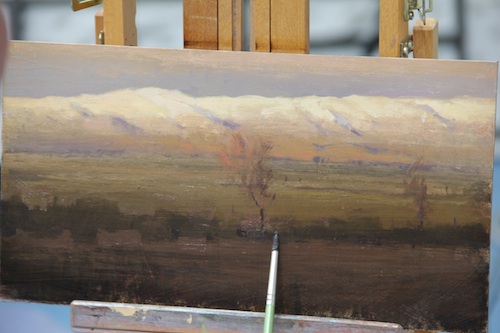 (Mike used this same little brush throughout the whole painting. He uses this brush on large and small paintings!)
(Mike used this same little brush throughout the whole painting. He uses this brush on large and small paintings!)
Michael Workman is a very generous teacher. He literally loves all aspects of his personal painting process from the panels that he makes, to applying paint, to the care he takes with his clean-up. Michael shared many of his secrets to painting and business success with us. This workshop class was filled with talented, professional artists who were all enthusiastic about pushing themselves to the next artistic level – so we learned a lot!
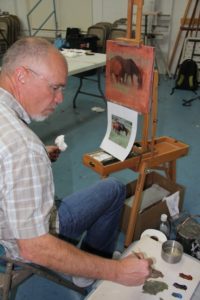
- Some of his favorite artists to study:
George Innes
Antonio Lopez
Golucho
Wayne Thiebeau
Stuart Shields
Victor Higgins
Egon Shiele
Gustave Bumann
Leaon Gaspard
Gustave Klimt
One of the workshop highlights was when we all enjoyed a day of ‘painting like Mike’ where we literally copied along with him as he painted. This was a successful learning exercise.
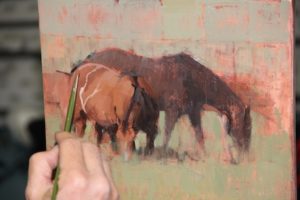
 (Our class ‘paint along’ copies of Michael’s horse demo)
(Our class ‘paint along’ copies of Michael’s horse demo)
Over the years, I have sought out my favorite painting mentors. Why? Because, although I majored in Art in college, I still consider myself self-taught. I learned how to draw very well from my high school teacher, but in college the curriculum was geared toward abstract art. As an aspiring realistic painter, I felt very frustrated with this and almost abandoned Art as a career.
I am grateful to artists such as Michael Workman who are confident and willing to share their talent and knowledge with others like myself. Mike challenged me and gave me some ‘homework’…I can’t wait to start working on my new series of paintings which will be inspired by my week with Michael Workman. ~Lori
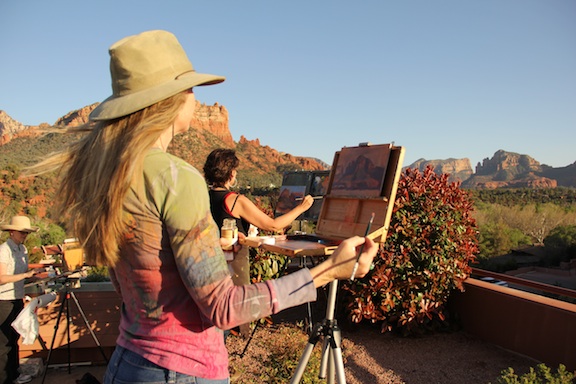

It would be great to meet you on my Facebook FineArtTips page where you can learn art tips and share what’s on your easel’ with me…and I hope you meet me on Twitter!
The Healthy Artist: Tips to Help You Stay that Way
10 Helpful Ways to Overcome Spring Fever in the Art Studio
Artistic Temperament: What to Do When it Strikes!
How to Jump-Start Your Art Career
10 Ways to Overcome Mental Blocks & Boost Creativity
Feeling Unproductive in the Studio or Office? How to Combat Spring Fever
How to Find Your Own Artistic Voice
How to ‘Jump-Start’ Your Art Career
6 Tips for a Stress-free Sketchbook
 Carlson’s Guide to Landscape Painting
Carlson’s Guide to Landscape Painting
This is an indispensable book and must-have for any serious landscape painter. The whys and hows of the various aspects of landscape painting. Angles and consequent values, perspective, painting of tree, more. 34 black and white reproductions of paintings by Carlson. 58 explanatory diagrams.
This is the artist’s bible and is owned by all the top artists!

Retail: $9.95
Your price: $8.46



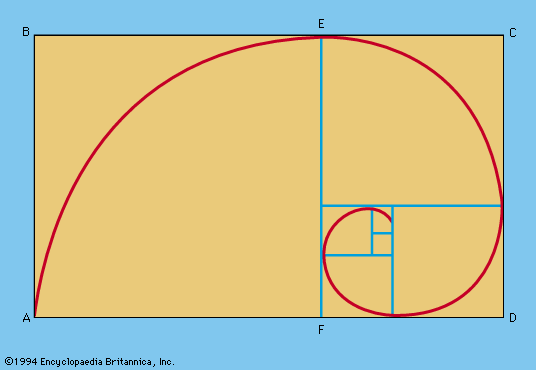
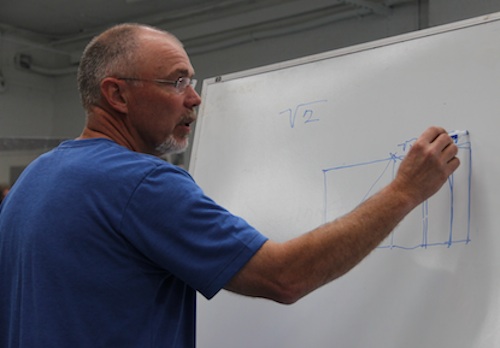


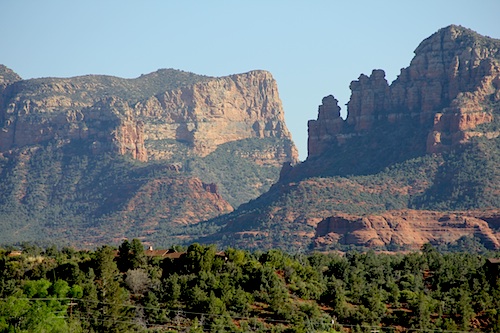






This is a great post! Thanks…it helps to learn about a new teacher. Love his palette. I agree w you re college, actually mine did all they could to beat the realist outta me. So I’m pretty self taught too, going to be doing a blog post re this very topic.
Thanks Ann. I would love to see you blog post on the ‘self taught’ subject. There are many of us out there!
I appreciate the comment! ~Lori
I read your tips all the time Lori, but this one is pretty special. Your excitment is jumping off the page. Your list of insightful quotes and detailed accounts now have a home in my studio. This was an espcially good read. Thank you. – Susan
Hi Lori ! Lucky you !!!!! I agree with Susan…your excitement is coming through ..LOUD and CLEAR….You are soooo generous on here, to give us a mini course of how your week went!! I enjoyed reading EVERYTHING…:)
I so look forward to everything you write , and everything you post (photos !!)
Michael Workmans work is wonderful…he has a wonderful website also (just checked it out !!)
Now , I just want to PAINT !!!
tHANKS AGAIN FOR SHARING – Debb Ferris Bates
Hi Debb-
It is great seeing you here! Thanks for the encouraging comment. Blogging is a lot of work and takes time away from my painting – but, comments like yours makes it all worth the effort. I am glad you enjoyed learning more about Michael.
Take care and happy painting-
Lori
Susan, I really appreciate the great feedback to this post. I am glad my excitement is jumping off the page – I can’t wait to get painting!
Cheers-
Lori
Lori, I’ve been following your blog for a few months now – which may sound unusual, because I’m not a painter. I’m a photographer – but my son is a painter (a budding one – but also a very good one), and I’ve encouraged him to follow your blog for your insights and expertise. This blog post is especially interesting to me because Mike is a friend of mine and a mentor of my son. It is posts like this one that keep me following your wonderful blog. Keep up the good work.
Hello Jim,
Thanks for taking time to comment and share your thoughts. What a nice compliment! Art and photography cross over in many ways and much of what I blog about can be applied toward photography – especially the composition and business aspects. I am glad your son is finding this site helpful too. It is interesting that you know Mike. Your son is one lucky fellow!!! I learned more from Mike’s workshop than I have from any other instructor. Now, I need to put it all to good use.
I hope to see you here again-
Lori 🙂
Ps. tell Mike hello for me!
Thanks for sharing your summary of the workshop. I think Michael’s work is excellent. I kick myself that I didn’t purchase a painting years ago when I first saw his work and he was not as well known. Judging from his work and your summary he’s a good person to take a class from.
Hi Shannon-
I am kicking myself too! Someday I hope to purchase a mini to add to my mini collection. Yes, I was really impressed with Mikes teaching ability and knowledge. That said, his style of teaching is geared toward advanced or advance intermediate painters. A ‘newbie’ might feel a bit lost.
Thanks for the comment-
Lori 🙂
Lori,
I felt incredibly fortunate to be in Michael’s workshop too! I am still processing all that was shared- definitely the best workshop I’ve ever attended. Of the ideas you posted- the one I’ve been thinking about most, is that what we leave out of a painting is more important than what we put in it. I tend to put in too much detail- and there by destroying the mystery in a piece. In addition to fabulous teaching, I’ve never attended a workshop where there was so much talent in the audience! You included! It is going to be exciting to see what everyone in the group does in the next year!
Mallory Agerton
Hi Mallory,
It is great seeing you on my blog! Thanks for taking time to comment. I too am processing all of the workshop information…and I am procrastinating a bit too! I am looking so forward to our reunion…time flies, so we have a lot of work to do before then!
Keep in touch and happy painting-
Lori
Hi Lori
As a UK-based painter, I’m very jealous of your session with Michael Workman. I’ve loved his work and frequently return to his website ever since seeing a small image in a copy of an American painting magazine a year or so ago. I’d love to have the opportunity to spend time with him and really sense your excitement. Maybe one day ….!
Malcolm
Hello Malcolm-
I feel really lucky to have met Michael and I live only one state away – lol! He calls himself a ‘dark horse’…a man of mystery. I have followed him for over a decade a am glad I finally was able to work with Workman! Thank you for the nice feedback.
Happy painting-
Lori
Thanks for the great post Lori! I love Michael Workman’s work and didn’t even know he did workshops. I’m really hoping to get in on his next one! Thanks again for your blog.
Hi Eden-
For years, I tried to find a MW workshop, but he was never teaching. Then, this one popped up and I jumped at the chance. Mike says he might not teach another one again…so, I feel lucky. He has a very different approach and his teaching are still settling in with me as I write this!
Thanks for the comment-
Lori 🙂
Thanks for the details. I have been wanting to join one of Michael’s classes for some time but live in Australia. Am hoping to get there in 2013. In the mean time this information is great. I had hoped he might make a dvd for those of us who can’t get there but no such luck.
Yes, that is a far trip to take for a workshop! I loved it though and it might be worth your time to take it. Mike doesn’t really like to teach and probably wont make a DVD…we asked him too also! Thanks for stopping by for a comment.
Best-
Lori
Oh, I do love Michael Workman’s work, so I was very happy to read your post. Listed as one of his inspirations is Stuart Shields, but the name is Stuart Shils, I believe— http://www.stuartshils.com He’s a wonderful painter that has evolved from his earlier days to a current more abstract style. I too have wondered about deconstructing a subject for a balance between realistic and abstract. I certainly would love to hear what Michael Workman had to say about that. Thanks.
Claudia
Hi, Claudia, I just finished a workshop with Michael in Fredericksburg, TX. I don’t think he enjoys teaching much. I wonder if he wouldn’t like to progress more in the way of Stuart Shils and break away from what he has been doing…but sometimes maybe sales keep an artist from making that break and they become stymied.
Hello Diane, thank you for stopping by for a comment. I don’t think Michael needs to teach, even though he doesn’t seem to like it much. He was very informative and I learned a lot of new ideas from him. He puts a lot of pressure on himself, but he is full on knowledge and I am grateful he is now sharing it with others.
Lori
Did Michael do critiques with your group? He was very harsh on our class. I think we were all a little shocked. Diane
Hi Diane,
I am catching up on comments today. Yes, Michael did critiques and he was very tough on us. That is why I went…I wanted someone to really look with a critical eye to help me to the next level. I even shed a tear! But, I am grateful to Mike for his candor and I am going to work with him again at his studio this May!
Happy painting-
Lori
Lori, thanks for a very interesting page. I’ll have the pleasure to join Michael for a workshop in September and this is great research. Very nice of you to post it. Dan
Hi Dan, I hope you have a great time working with Mike. Please tell him ‘Lori’ says hello.
Cheers,
Lori
Lori,
Thanks for creating this blog! I am a big fan of Michael Workman, and I have been dying to go to one of his workshops. Your blog is very informative, interesting, and inspiring.
I noticed that your paintings are very nice as well.
Keep it up!
L. Jay
So happy this blog post helped you! It was a great workshop and worth the money and effort.
Lori
Thanks for this very interesting and inspiring article. I love his work. You describe his technique very well. I was surprised to see that his still prepares his boards. He also uses beautiful frames. I wonder if he has discussed this or if you know where he gets his frames?
Thank you
Hello Robert, I’m happy to hear you enjoyed this post. It was really fascinating watching Mike paint. He didn’t share his framing source, but I know there are some great frame makers near him in Utah. One of them is http://rockymountainframes.com/welcome-full-width/. They do a beautiful job. I hope this helps. Thanks for the visit.